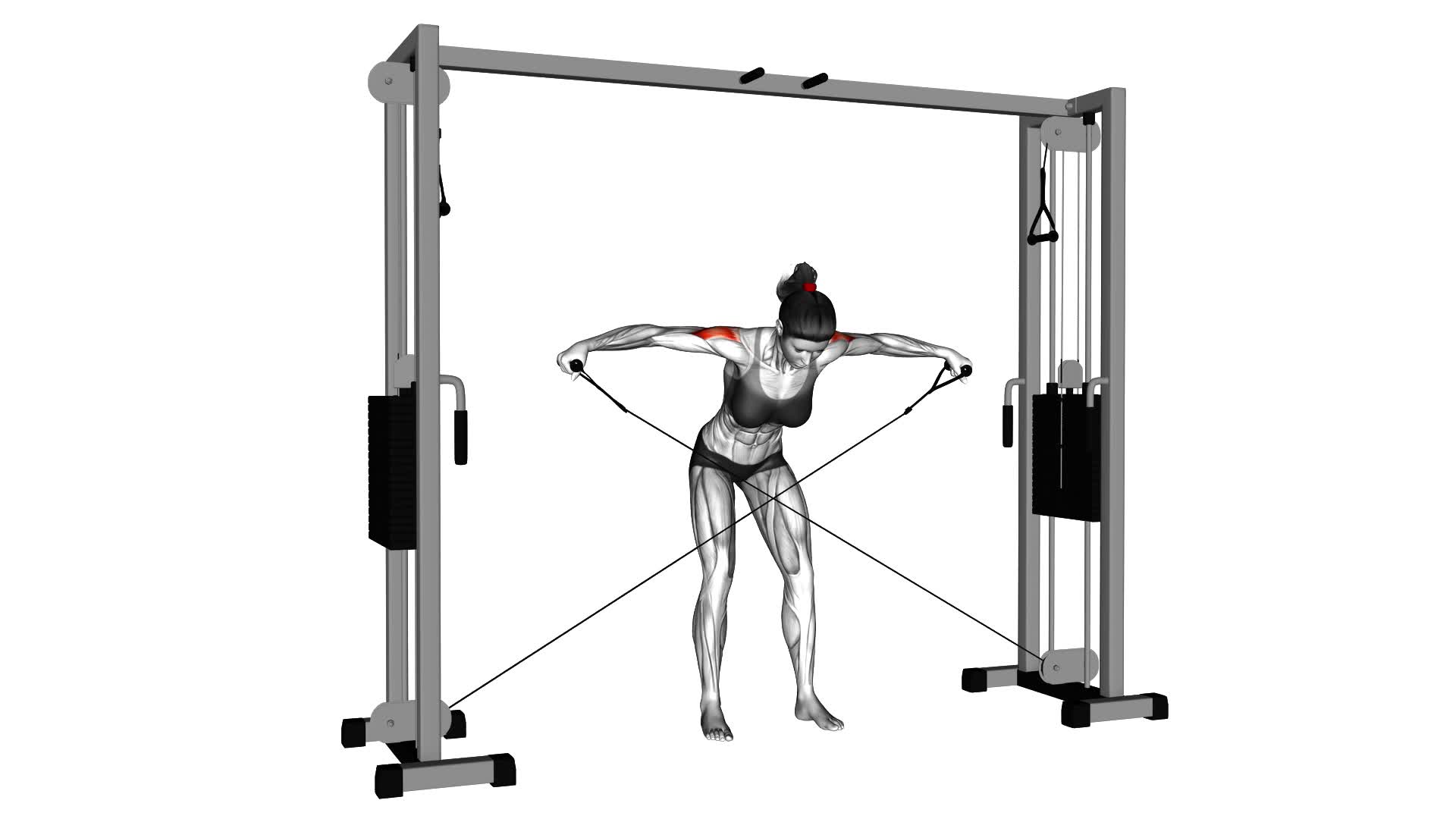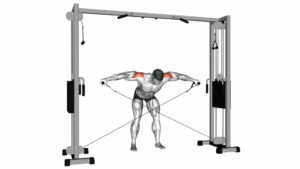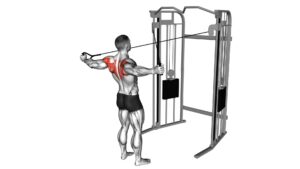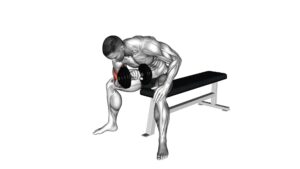Cable Cross Over Revers Fly (Female) – Video Exercise Guide & Tips

Are you looking for a challenging exercise that targets your upper body? Look no further than the Cable Cross Over Reverse Fly!
Watch This Exercise Video
This video exercise guide and tips will show you how to perform this effective move with proper form and technique. Learn about the benefits of this exercise, common mistakes to avoid, and different variations for all fitness levels.
Incorporate the Cable Cross Over Reverse Fly into your workout routine and watch your upper body strength soar!
Key Takeaways
- Targets rear deltoids, upper back, and shoulder muscles
- Improves posture by strengthening upper back muscles
- Increases shoulder stability and reduces risk of injuries
- Enhances upper body strength and muscle tone
Benefits of the Cable Cross Over Reverse Fly
Discover the benefits you can achieve with the Cable Cross Over Reverse Fly exercise. This exercise primarily targets your rear deltoids, upper back, and shoulder muscles, helping you develop a strong and defined upper body. One of the key benefits of the cable cross over reverse fly is improved posture. As you strengthen your upper back muscles, you can better support your spine, reducing the risk of slouching and promoting a more upright posture.
Another benefit is increased shoulder stability. By engaging your shoulder muscles during this exercise, you enhance their strength and stability, which can help prevent shoulder injuries during other activities. Additionally, the cable cross over reverse fly can improve your overall upper body strength and muscle tone, giving you a more sculpted appearance.
To cater to different fitness levels, there are variations and modifications for the cable cross over reverse fly. Beginners can start with lighter weights and focus on mastering proper form and technique before gradually increasing the resistance. For those with more advanced fitness levels, incorporating different angles or using heavier weights can provide an additional challenge.
Incorporating the cable cross over reverse fly into your workout routine can yield significant benefits such as improved posture, increased shoulder stability, and enhanced upper body strength. Remember to always listen to your body and consult with a fitness professional if you have any concerns or questions.
Equipment Needed for the Exercise
To perform the Cable Cross Over Reverse Fly exercise, you'll need specific equipment. The main piece of equipment required for this exercise is a cable machine, which consists of a weight stack, pulleys, and cables. This machine allows you to adjust the weight and resistance according to your fitness level and goals.
The benefits of resistance training, such as the Cable Cross Over Reverse Fly, are numerous. Resistance training helps to increase muscle strength and endurance, improve bone density, and enhance overall physical performance. It also helps to boost metabolism and promote fat loss, making it an effective exercise for weight management.
If you don't have access to a cable machine, there are alternative exercises that you can do to target the same muscle groups. One alternative is the Bent-Over Dumbbell Reverse Fly, which requires only a pair of dumbbells. Another option is the Resistance Band Reverse Fly, which utilizes resistance bands to provide resistance.
Proper Form and Technique
To perform the Cable Cross Over Reverse Fly exercise with proper form and technique, you should ensure that you maintain a controlled and stable posture throughout the movement. Start by standing in the middle of the cable crossover machine, with feet shoulder-width apart and a slight bend in your knees. Grasp the handles with an overhand grip, keeping your arms extended in front of you. Begin the exercise by squeezing your shoulder blades together and pulling the handles out to your sides. Keep your elbows slightly bent and your wrists straight. As you bring your arms back, focus on contracting your upper back muscles. Slowly return to the starting position and repeat for the desired number of reps.
When performing this exercise, it's important to avoid common mistakes such as using excessive weight, rounding your shoulders, or swinging your body. These errors can't only decrease the effectiveness of the exercise but also increase the risk of injury. Remember to maintain proper form and control throughout the entire movement.
There are also variations and modifications you can try to target different muscles or accommodate any limitations. You can perform this exercise using resistance bands instead of a cable machine, or you can use dumbbells for a seated variation. Additionally, adjusting the height of the cable handles or changing your grip can also provide different challenges and work different muscle groups.
Now, let's move on to the next section where we'll discuss common mistakes to avoid when performing the Cable Cross Over Reverse Fly exercise.
Common Mistakes to Avoid
To ensure you get the most out of your Cable Cross Over Reverse Fly exercise, it's important to be aware of common mistakes to avoid.
One common error is using too much weight, which can compromise your form and put unnecessary strain on your muscles.
Another mistake isn't maintaining a stable core, as this can lead to improper alignment and decreased effectiveness of the exercise.
Lastly, rushing through the movement without focusing on the contraction and control can limit the benefits of the exercise.
Proper Form Demonstration
Avoid these common mistakes when performing the Cable Cross Over Reverse Fly exercise:
- Improper stance: Ensure you have a stable and balanced stance, with your feet shoulder-width apart and knees slightly bent. This will help you maintain control and stability throughout the movement.
- Using excessive weight: Don't be tempted to use heavy weights that compromise your form. Start with lighter weights and focus on maintaining proper form throughout the exercise.
- *Demonstration tips:* Watch instructional videos or seek guidance from a fitness professional to ensure you understand the correct form and technique.
- *Exercise modifications:* If you find the exercise too challenging, you can perform it seated or decrease the weight to maintain proper form and prevent injury.
Common Technique Errors
Correct your technique to avoid these common mistakes when performing the Cable Cross Over Reverse Fly exercise.
One common technique error is using too much weight. This often leads to improper form and can put unnecessary strain on your muscles and joints. To fix this, start with a lighter weight and focus on maintaining proper form throughout the exercise.
Another mistake to avoid is rounding your shoulders or hunching your back. This can diminish the effectiveness of the exercise and increase the risk of injury. To fix this, engage your core muscles and maintain a straight and upright posture throughout the movement.
Lastly, be mindful of using momentum to complete the exercise. This can cheat the targeted muscles and prevent them from fully engaging. Instead, focus on controlled and deliberate movements to maximize the benefits of the exercise.
Variations and Modifications for Different Fitness Levels
How can you modify the Cable Cross Over Reverse Fly exercise to accommodate different fitness levels?
Here are some modifications for beginners:
- Start with lower weight or resistance to build strength gradually.
- Focus on maintaining proper form and range of motion rather than lifting heavy weights.
- Perform the exercise with your feet closer together to provide more stability.
Advanced variations:
- Increase the weight or resistance to challenge your muscles further.
- Try performing the exercise on one leg to engage your core and improve balance.
- Incorporate a stability ball or Bosu ball to increase instability and engage more muscles.
By modifying the Cable Cross Over Reverse Fly exercise, beginners can gradually build strength and improve their form, while advanced individuals can challenge themselves and continue to progress.
Remember to always listen to your body and adjust the exercise according to your fitness level. Consulting with a fitness professional can also provide valuable guidance and ensure proper execution of the exercise.
Tips for Incorporating the Exercise Into Your Workout Routine
To effectively incorporate the Cable Cross Over Reverse Fly exercise into your workout routine, consider adding it as a compound movement to target multiple muscle groups simultaneously. This exercise primarily targets the muscles in your upper back, rear shoulders, and mid-back, but it also engages your core and stabilizer muscles.
To begin, set the cables at shoulder height and stand in the middle of the machine. Hold the handles with an overhand grip, arms extended in front of you. Step back slightly, keeping a slight bend in your knees and maintaining a neutral spine. Engage your core and squeeze your shoulder blades together as you pull the handles out to the sides, keeping your arms straight. Pause for a moment at the peak contraction, then slowly release back to the starting position.
Incorporating cardio into your workout routine is important for overall fitness and heart health. After completing a set of Cable Cross Over Reverse Fly, consider adding a few minutes of cardio, such as jogging or jumping rope, to increase your heart rate and enhance calorie burn.
Don't forget the benefits of stretching before and after your workout. Stretching helps improve flexibility, range of motion, and blood flow to your muscles. Prioritize stretching the muscles targeted in the Cable Cross Over Reverse Fly, such as your upper back and shoulders, to prevent muscle imbalances and reduce the risk of injury. Remember to hold each stretch for 15-30 seconds and breathe deeply while stretching.
Incorporating the Cable Cross Over Reverse Fly into your workout routine can help improve your upper body strength and posture. By adding cardio and stretching, you can further enhance the benefits of this exercise and promote overall fitness and well-being.
Frequently Asked Questions
How Many Sets and Reps Should I Do for the Cable Cross Over Reverse Fly Exercise?
To determine the number of sets and reps for the cable cross over reverse fly exercise, it's important to consider your fitness level and goals.
Beginners can start with 2-3 sets of 8-12 reps, gradually increasing as they become more comfortable.
This exercise is great for shoulder strength and can be modified for beginners by using lighter weights or resistance bands.
The cable cross over reverse fly targets the upper back and rear shoulders, improving posture and overall upper body stability.
Can I Substitute the Cable Machine With Dumbbells for This Exercise?
Yes, you can substitute the cable machine with dumbbells for this exercise. Dumbbell variations of the cable cross over reverse fly can be just as effective in targeting your rear deltoids and upper back muscles.
Is It Necessary to Warm up Before Performing the Cable Cross Over Reverse Fly?
Before performing any exercise, it's necessary to warm up to prepare your muscles and joints for the activity. Warming up helps increase blood flow and flexibility, reducing the risk of injury.
Additionally, if you don't have access to a cable machine, you can still target the same muscles by using dumbbells for variations of the cable cross over reverse fly exercise. It's important to choose a weight that challenges you while maintaining proper form.
Can This Exercise Help in Reducing Back Pain?
The cable cross over reverse fly exercise can be beneficial for reducing back pain when incorporated into a full body workout routine.
By targeting the muscles in the upper back and shoulders, this exercise helps to improve posture and strengthen the back muscles, which can alleviate back pain.
To modify the exercise for individuals with existing back pain, it's important to start with light weights and focus on proper form.
Consulting with a fitness professional can provide further guidance.
How Long Should I Rest Between Sets While Performing the Cable Cross Over Reverse Fly?
When performing the cable cross over reverse fly, it's important to know how long you should rest between sets. The rest period will depend on your fitness level and goals.
Generally, a rest period of 30-60 seconds is recommended to allow your muscles to recover and maintain proper form. This will help prevent fatigue and reduce the risk of injury.
Remember to listen to your body and adjust the rest period as needed.
Conclusion
Incorporating the Cable Cross Over Reverse Fly into your workout routine can have numerous benefits for females. This exercise targets the muscles in the upper back and shoulders, helping to improve posture and strengthen the upper body.
By using proper form and technique, you can avoid common mistakes and maximize the effectiveness of the exercise. Additionally, variations and modifications allow for customization based on fitness levels.
Add this exercise to your routine for a stronger, more sculpted upper body.

Author
Years ago, the spark of my life’s passion ignited in my mind the moment I stepped into the local gym for the first time. The inaugural bead of perspiration, the initial endeavor, the very first surge of endorphins, and a sense of pride that washed over me post-workout marked the beginning of my deep-seated interest in strength sports, fitness, and sports nutrition. This very curiosity blossomed rapidly into a profound fascination, propelling me to earn a Master’s degree in Physical Education from the Academy of Physical Education in Krakow, followed by a Sports Manager diploma from the Jagiellonian University. My journey of growth led me to gain more specialized qualifications, such as being a certified personal trainer with a focus on sports dietetics, a lifeguard, and an instructor for wellness and corrective gymnastics. Theoretical knowledge paired seamlessly with practical experience, reinforcing my belief that the transformation of individuals under my guidance was also a reflection of my personal growth. This belief holds true even today. Each day, I strive to push the boundaries and explore new realms. These realms gently elevate me to greater heights. The unique combination of passion for my field and the continuous quest for growth fuels my drive to break new ground.



